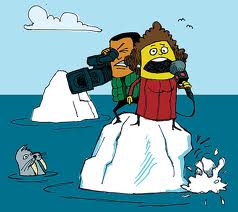 The majority of news items are based on information provided by public relations people via news releases, news conferences and staged events. News is also shaped by the choice of people journalists interview for research, quotes and on-air appearances, that is, their sources.
The majority of news items are based on information provided by public relations people via news releases, news conferences and staged events. News is also shaped by the choice of people journalists interview for research, quotes and on-air appearances, that is, their sources.
In addition, most media organisations are owned by multi-national multi-billion dollar corporations that are involved in a number of businesses apart from the media, such as forestry, pulp and paper mills, defence, real estate, oil wells, agriculture, steel production, railways, water and power utilities. Such conglomerates not only create potential conflicts of interest in reporting the news but ensure the makers of the news take a corporate view.
Various former environmental writers claim to have been victimised or lost their jobs for investigating stories that their employers would rather not have investigated or for their perceived environmental bias. Bruce Selcraig in Sierra gives examples of several environmental journalists in the West of the US who “were reassigned or simply made so miserable they left.” He quotes Jim Detjen, who is President of the rapidly growing Society of Environmental Journalists: “Virtually every veteran environmental writer I know, has been threatened with the loss of his or her job at one time or another.”
Media reporting of environmental problems increased at the end of the 1980s reaching a peak in 1989/90 in many countries around the world and declining steadily after that. Studies of media content in the US show that environmental coverage in the early 1990s was less than 2% despite the high level of concern amongst the public.
After the initial flurry of crisis reports around 1989/90, the media settled into a phase that has been variously referred to by environmentalists as ‘revisionist’ and ‘backlash’. Environmental stories in the 1990s cast doubt on the crisis stories that the media had featured earlier. The stories tended to have an economic framing, focusing on the costs of regulation in terms of jobs and money.
 The media also “played a decisive role in publicizing and spreading anti-environmental initiatives”, giving plenty of attention to the Wise Use Movement and ignoring the obvious part played by corporate interests in mobilising loggers and others for maximum media impact.
The media also “played a decisive role in publicizing and spreading anti-environmental initiatives”, giving plenty of attention to the Wise Use Movement and ignoring the obvious part played by corporate interests in mobilising loggers and others for maximum media impact.
Those who have sought to cast doubt on global warming and then ozone depletion have found a ready audience in environmental journalists at some of the top newspapers. Environmental journalist Kevin Carmody observes; “By 1994, the Los Angeles Times, ABC News and the Chicago Sun-Times, among others, were taking the iconoclastic position that Americans were being unnecessarily frightened about everything from street crime to pollution...”
David Shaw in the Los Angeles Times, argued in “Living Scared: Why Do the Media Make Life Seem so Risky?” that people are less likely to die from cancer (except lung cancer) and therefore the dangers posed by environmental pollutants are exaggerated. He neglected to point out that a major reason why death rates have fallen is not that people are exposed to fewer carcinogens but that they seek treatment earlier and get better treatments for some types of cancers.
 Keith Schneider, at the New York Times, became notorious in the early 1990s for his revisionist stories which argue that environmental hazards such as contaminated sites are not as dangerous as once thought: “Many experts... question the wisdom of spending billions of dollars to protect people from traces of toxic compounds... [M]any scientists, economists, and government officials have reached the dismaying conclusion that much of America’s environmental program has gone seriously awry.”
Keith Schneider, at the New York Times, became notorious in the early 1990s for his revisionist stories which argue that environmental hazards such as contaminated sites are not as dangerous as once thought: “Many experts... question the wisdom of spending billions of dollars to protect people from traces of toxic compounds... [M]any scientists, economists, and government officials have reached the dismaying conclusion that much of America’s environmental program has gone seriously awry.”
Boyce Rensberger, at the Washington Post, also caused much controversy, including a rebuttal from the American Chemical Society, with his claims that ozone depletion was being solved “before they can find any solid evidence that serious harm was or is being done” and with his favourable and extensive coverage of Patrick Michaels’ claims that global warming could be beneficial. Michaels published a magazine funded by coal companies and received funds from vested interests. However these connections were not mentioned in Boyce’s article.
In this way the media have given the doubts raised by industry-funded scientists a status above and beyond that given to them within the scientific community. This exaggerates the uncertainty associated with these environmental hazards which helped to undermine efforts to regulate them. Writing in the environmental magazine Sierra, Paul Rauber said:
most reporters don’t know much about science, and are unable to distinguish legitimate scientific dispute from bogus posturing...fewer than a dozen scientists, many of them on the payroll of coal and energy companies, say not to worry. On the evening news, both sides get equal time...
No matter how thoroughly their charges were debunked, however, the skeptics and the fossil-fuel industry got what they were after: a shadow of a doubt far larger than the facts warrant, and a ready-made excuse for timid legislators to stick with the status quo.
 Whilst mainstream media outlets were downplaying environmental problems, others took the opportunity to make money out of audiences that are concerned about those problems. Three new environmentally oriented television channels were set up in 1995 in response to the 20% of US citizens who were active environmentalists and the 35% who cared enough about the environment to change their shopping decisions. These people represented a market opportunity rather than an information gap. For example, the founder of Ecology Channel, Eric McLamb apparently “has no qualms about saying the venture’s primary purpose is to provide entertainment and make money.”
Whilst mainstream media outlets were downplaying environmental problems, others took the opportunity to make money out of audiences that are concerned about those problems. Three new environmentally oriented television channels were set up in 1995 in response to the 20% of US citizens who were active environmentalists and the 35% who cared enough about the environment to change their shopping decisions. These people represented a market opportunity rather than an information gap. For example, the founder of Ecology Channel, Eric McLamb apparently “has no qualms about saying the venture’s primary purpose is to provide entertainment and make money.”
I don’t know about the survivability of a 24-hour station that does nothing but bash corporations... Do you want to see hour after hour that shows destruction and environmental catastrophe? Hour after hour saying you’ve got to change?....It turns off so many people and turns off corporations, and that’s your money source.
The channel used PR firm E. Bruce Harrison for public relations and to “help us develop educational material for schools to make sure the right message goes out that everyone agrees on.” McLamb said the channel would show “a happy, prosperous lifestyle in harmony with the environment” with programmes such as The Jungle Book and The Home Gardening Club. “Ours is a feel-good show” said McLamb.
Another cable channel launched around the same time was Planet Central Television which aimed to cover social issues including environmental issues as well as having “lots of entertainment”. It hoped to get “a revenue stream impelled by ‘infomercials’”, advertising and commercial sponsorship: “We are going after a trillion dollars worth of business that is not in television right now.”